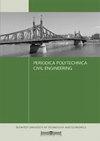Data-driven Dynamic-classifiers-based Seismic Failure Mode Detection of Deep Steel W-shape Columns
IF 1.4
4区 工程技术
Q3 ENGINEERING, CIVIL
引用次数: 3
Abstract
It is vital to assess the health of buildings following a major earthquake. New technologies such as deep learning algorithms have grown increasingly tempting in such rapid applications because of their increased reliabilities and simplicity to traditional methods. Due to the kinematics of steel moment frames, inelastic deformations tend to concentrate within the steel column during an earthquake, resulting in local or global buckling. Rapid failure mode detection of the existing deep steel W-shape columns (DSWCs) cannot be quickly identified due to a lack of comprehensive empirical and mechanics-based models. This research proposed a machine learning (ML) algorithm based on the state-of-the-art techniques of dynamic classifiers for failure mode forecasting of the DSWCs using an experimental database and illustrated why the ML model suggests a specific failure mode for a particular sample. The database was created by combining 939 instances from various studies that have been published. A total of six machine learning models based on Dynamic Selection strategy were implemented. Three metrics, i.e., accuracy, precision, and recall, were used to evaluate the performance of models. As a result of the extensive examination, a machine learning model based on the META-DES model was proposed. In the training stage, Overall Local Accuracy, A-Priori, and META-DES algorithms, received the highest score (>0.96) across all criteria. The META-DES model correctly predicted the failure mode of the DSWCs with an accuracy of 0.907 in the testing phase. The META-DES algorithm performed better than previous methods which are employed to identify the failure mode.基于数据驱动的动态分类器的深钢w形柱地震失效模式检测
大地震后对建筑物的健康状况进行评估是至关重要的。深度学习算法等新技术在如此快速的应用中变得越来越有吸引力,因为它们比传统方法更可靠,更简单。由于钢弯矩框架的运动特性,在地震中,非弹性变形往往集中在钢柱内部,导致局部或整体屈曲。由于缺乏全面的经验和基于力学的模型,现有深钢w形柱(dswc)的快速失效模式检测无法快速识别。本研究提出了一种基于最先进的动态分类器技术的机器学习(ML)算法,用于使用实验数据库预测dswc的故障模式,并说明了为什么ML模型会对特定样本提出特定的故障模式。该数据库是通过结合已发表的各种研究中的939个实例创建的。实现了基于动态选择策略的6个机器学习模型。三个指标,即准确性,精密度和召回率,被用来评估模型的性能。在此基础上,提出了基于META-DES模型的机器学习模型。在训练阶段,Overall Local Accuracy、A-Priori和META-DES算法在所有标准中得分最高(>0.96)。META-DES模型在测试阶段准确预测了dswc的失效模式,准确率为0.907。META-DES算法在故障模式识别方面优于以往的方法。
本文章由计算机程序翻译,如有差异,请以英文原文为准。
求助全文
约1分钟内获得全文
求助全文
来源期刊

Periodica Polytechnica-Civil Engineering
工程技术-工程:土木
CiteScore
3.40
自引率
16.70%
发文量
89
审稿时长
12 months
期刊介绍:
Periodica Polytechnica Civil Engineering is a peer reviewed scientific journal published by the Faculty of Civil Engineering of the Budapest University of Technology and Economics. It was founded in 1957. Publication frequency: quarterly.
Periodica Polytechnica Civil Engineering publishes both research and application oriented papers, in the area of civil engineering.
The main scope of the journal is to publish original research articles in the wide field of civil engineering, including geodesy and surveying, construction materials and engineering geology, photogrammetry and geoinformatics, geotechnics, structural engineering, architectural engineering, structural mechanics, highway and railway engineering, hydraulic and water resources engineering, sanitary and environmental engineering, engineering optimisation and history of civil engineering. The journal is abstracted by several international databases, see the main page.
 求助内容:
求助内容: 应助结果提醒方式:
应助结果提醒方式:


